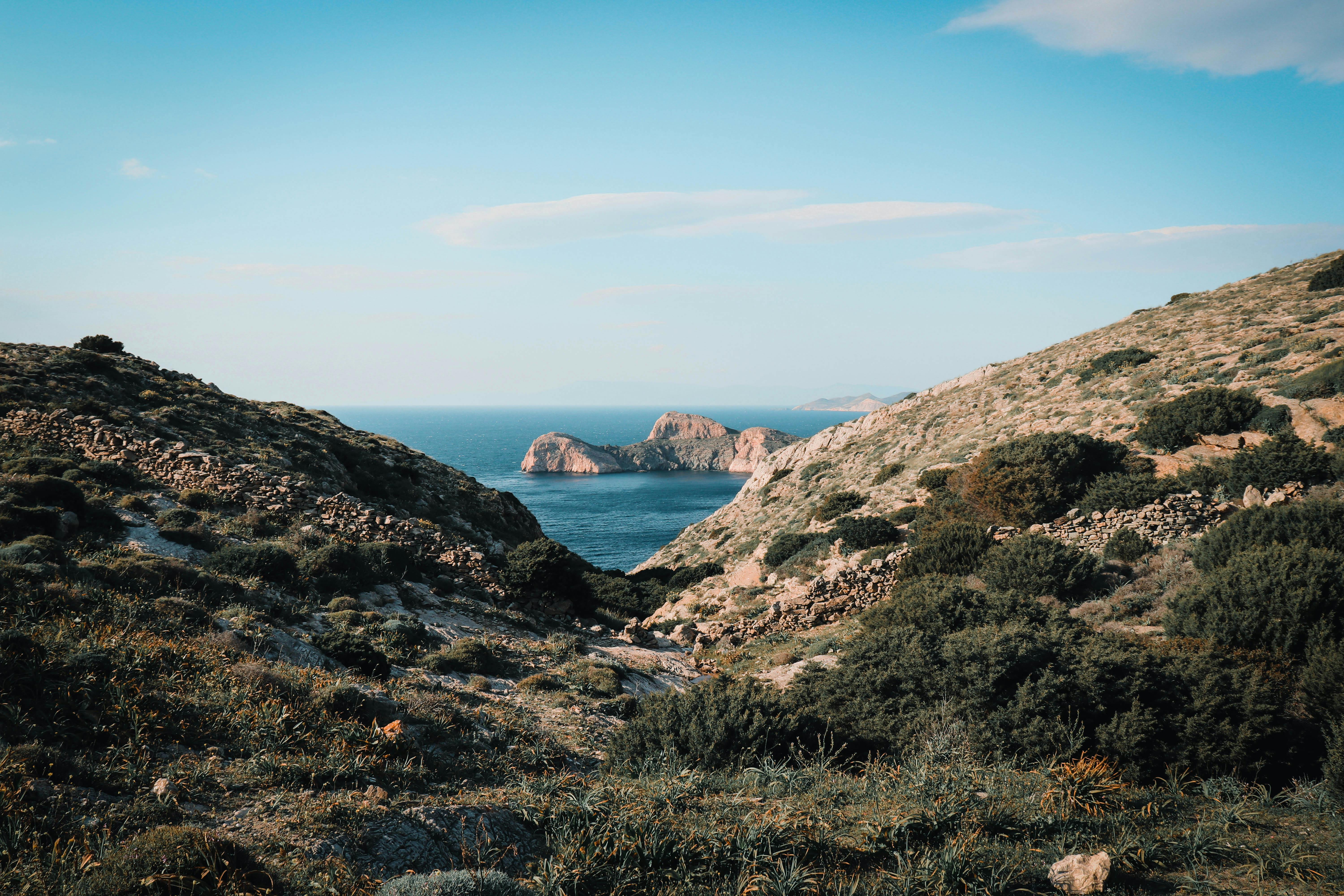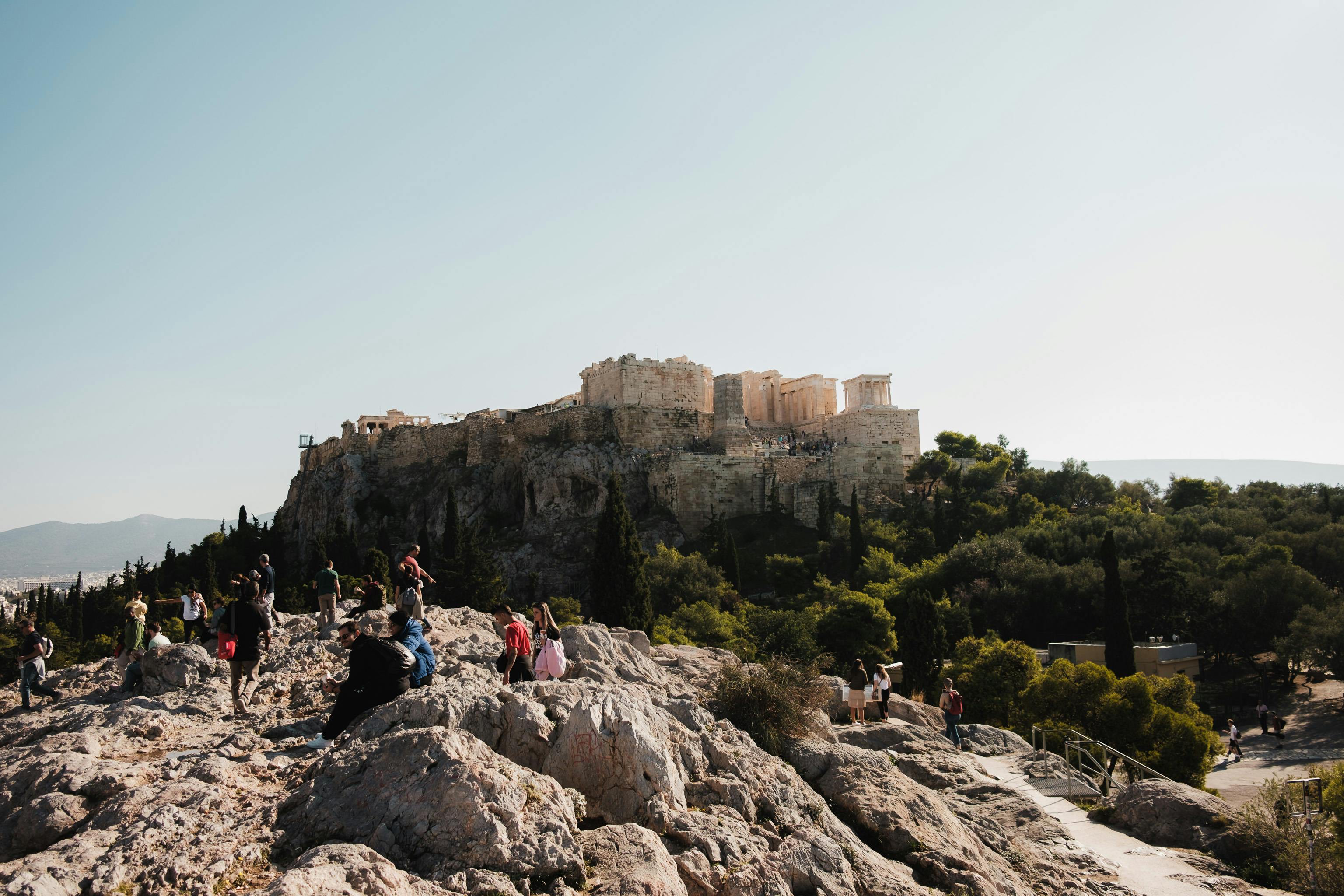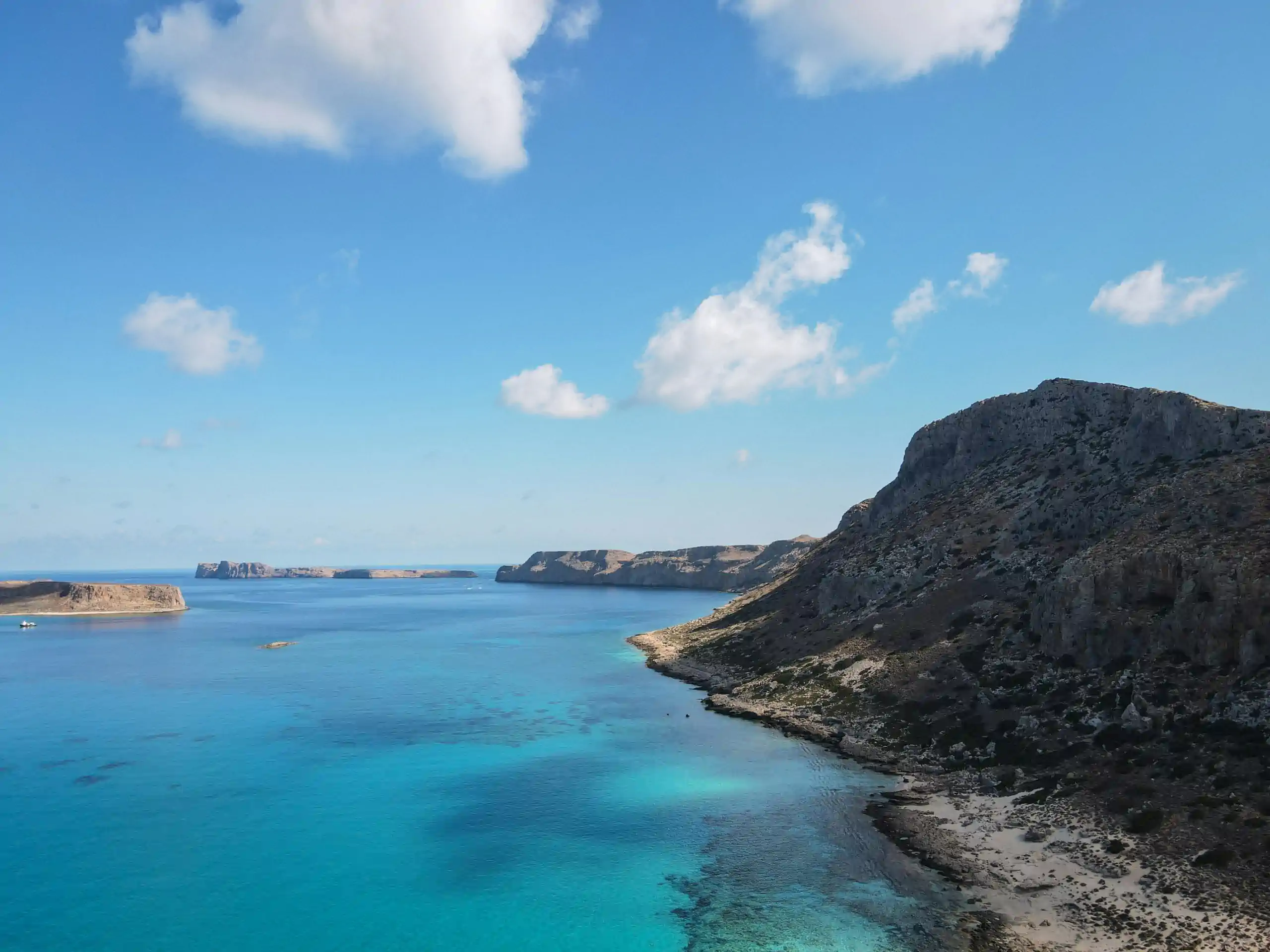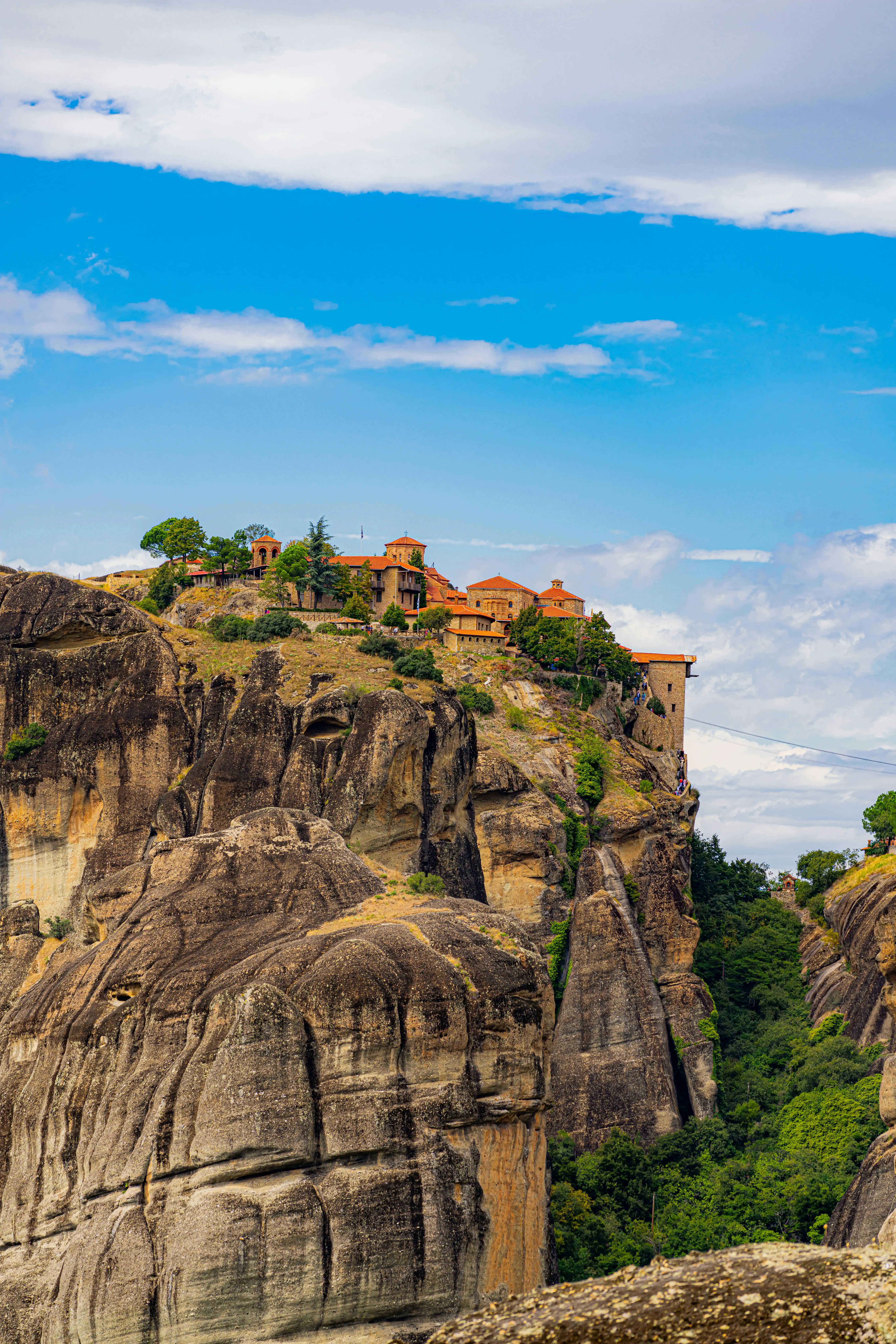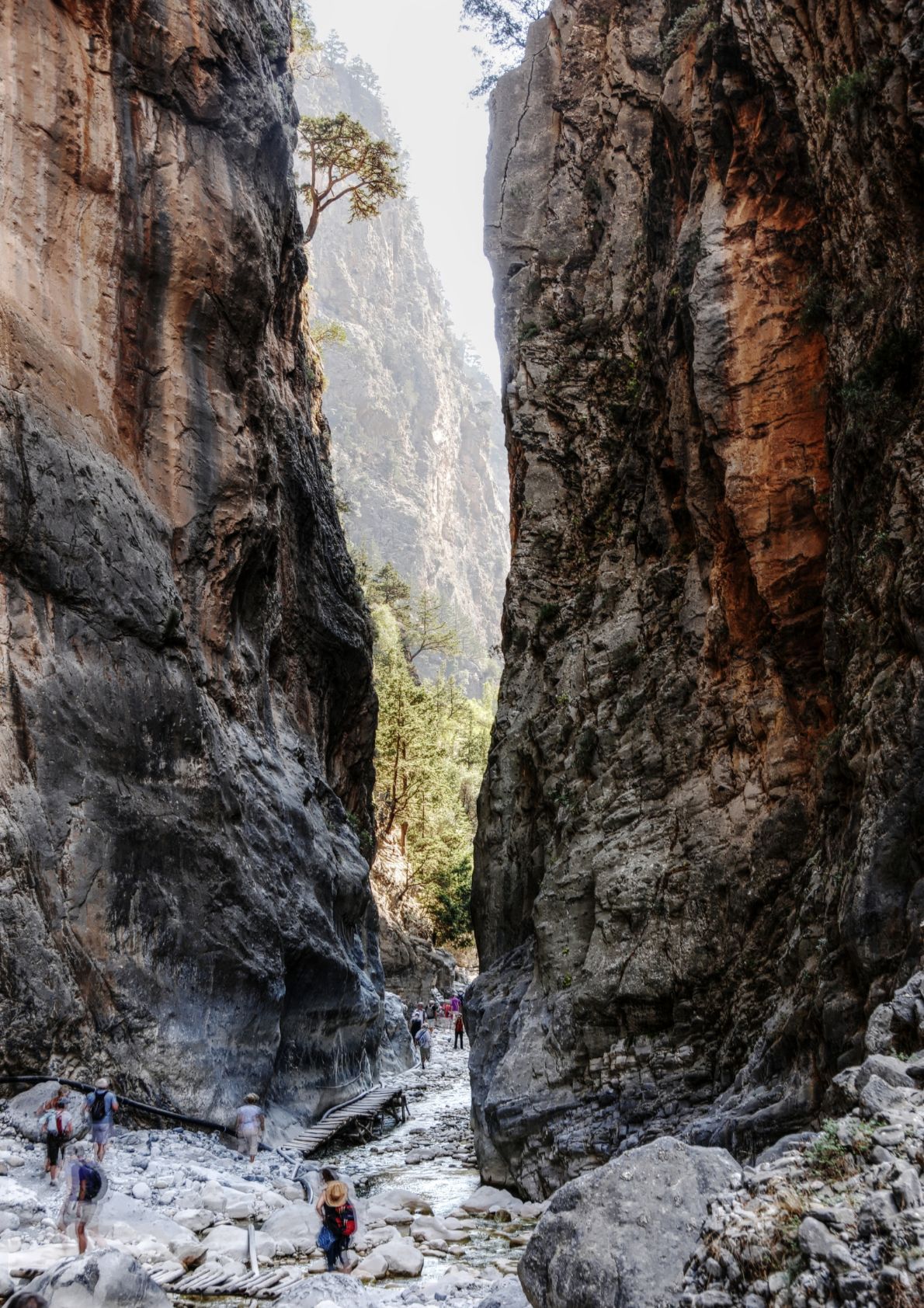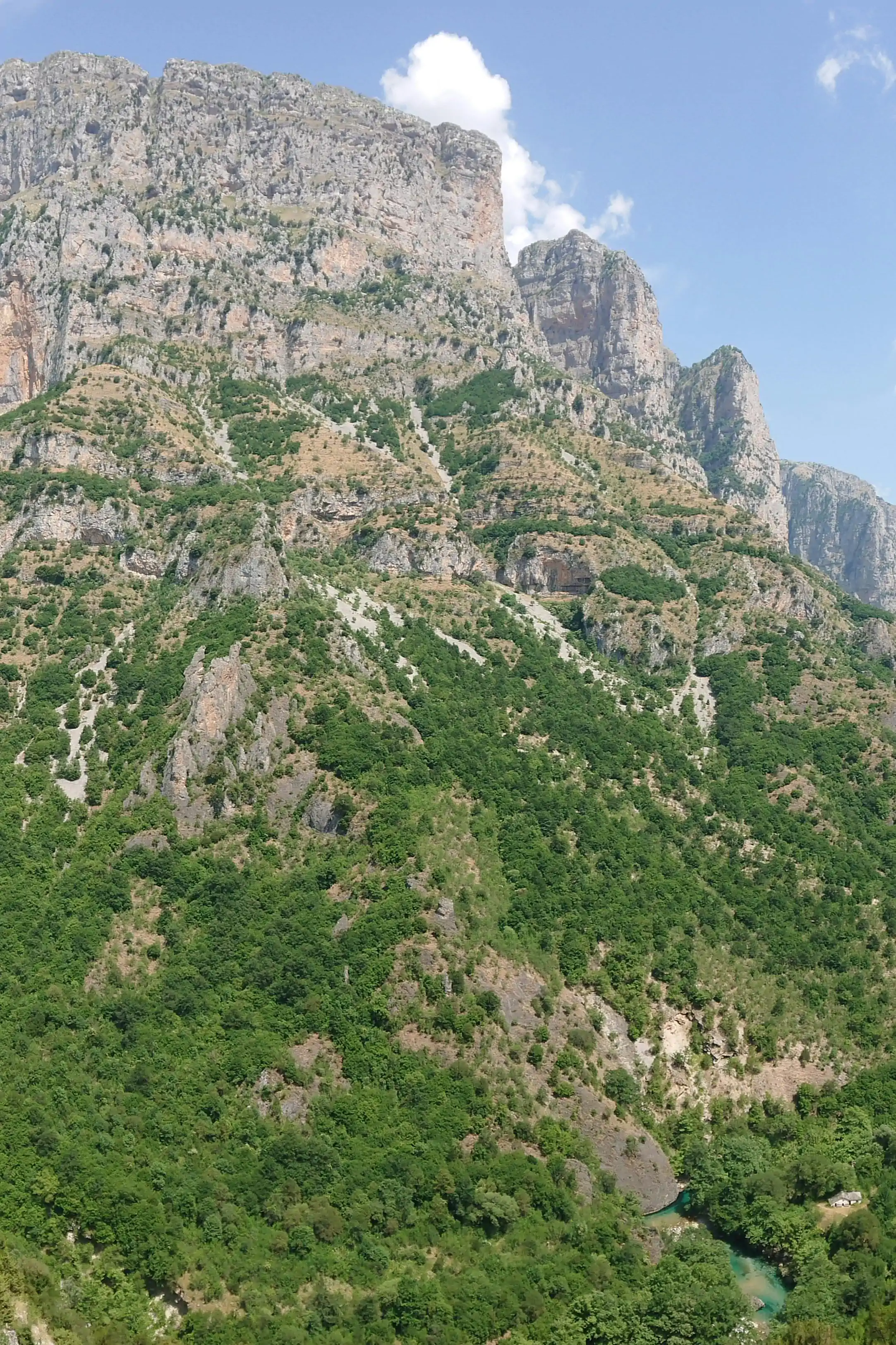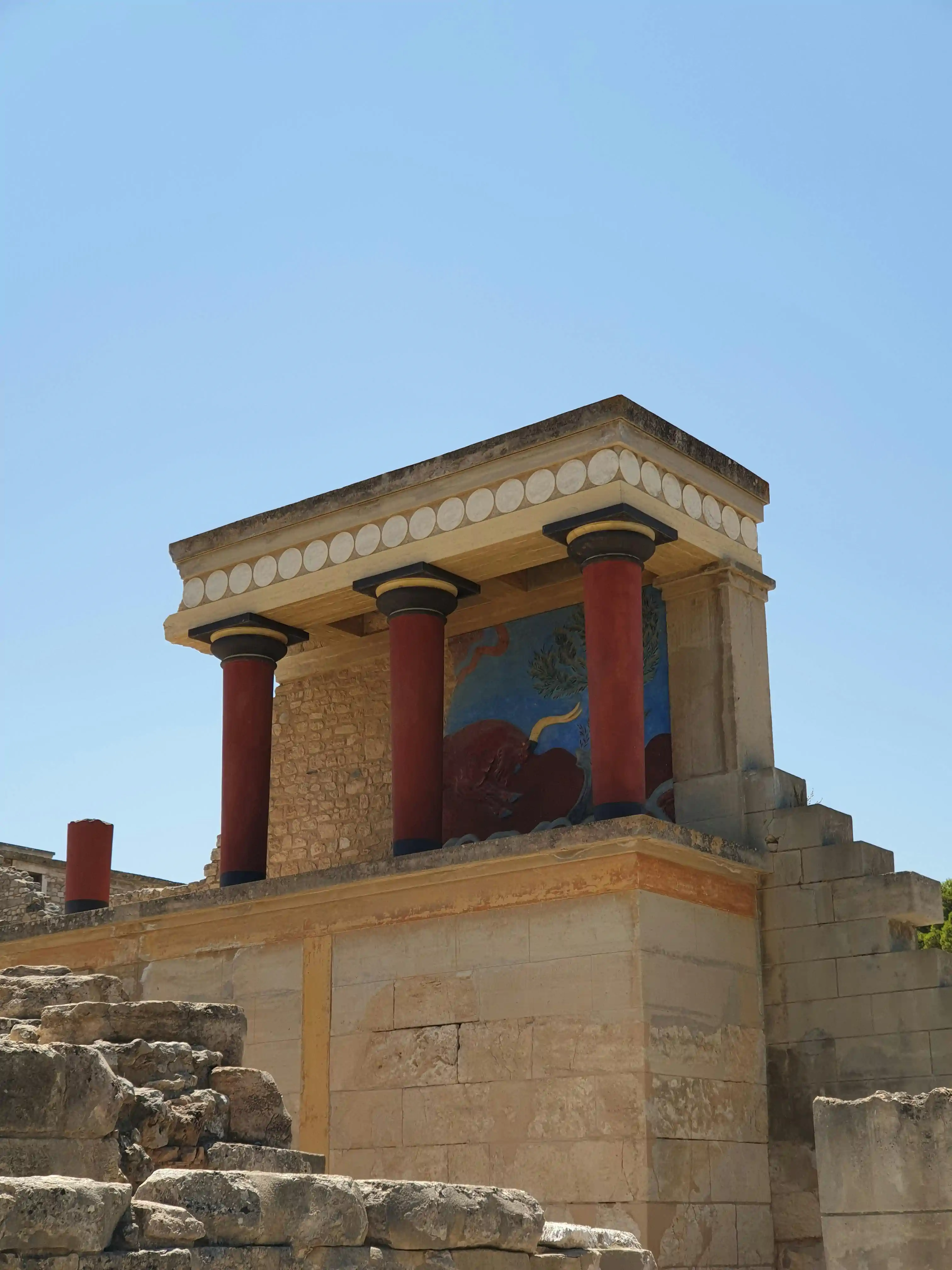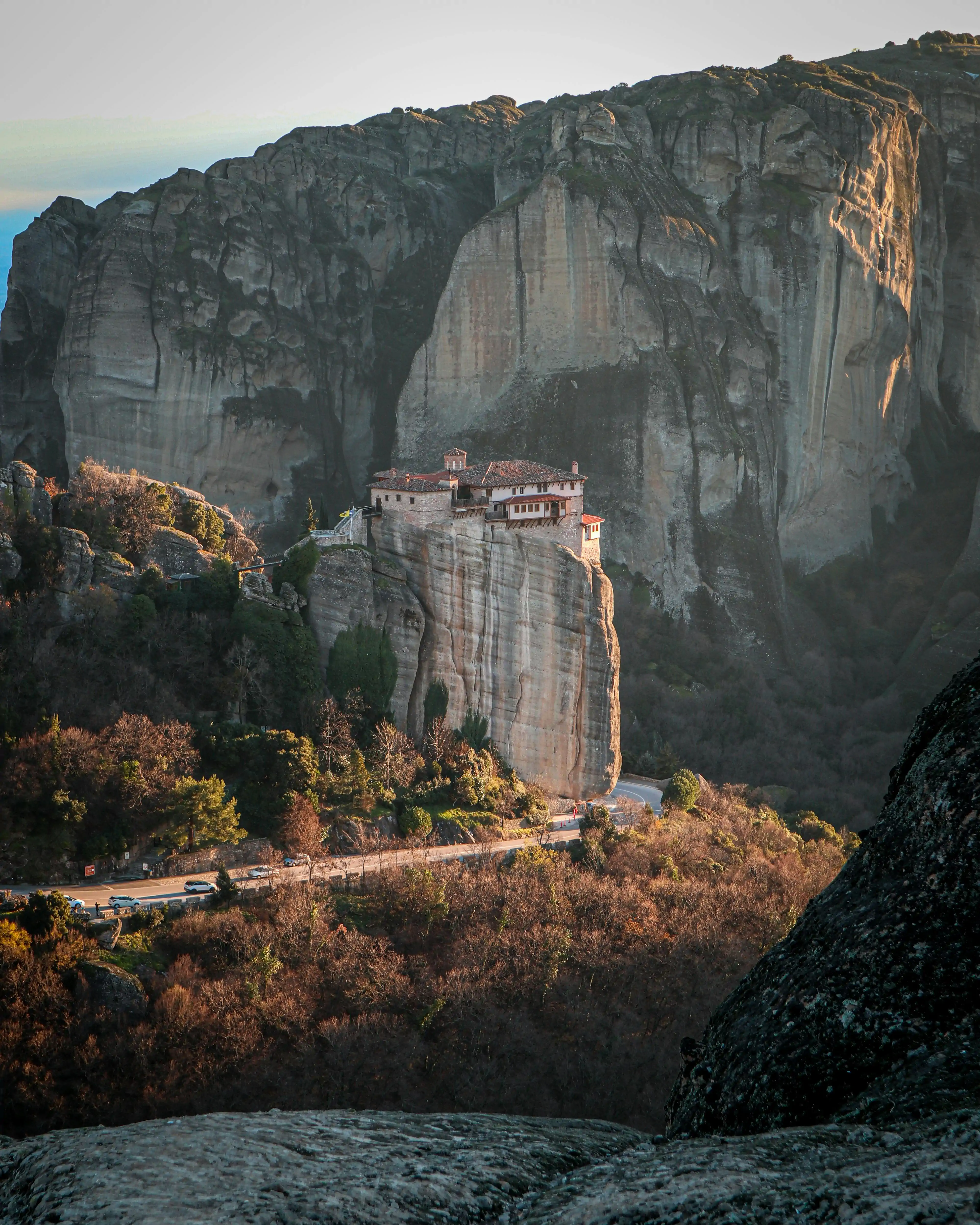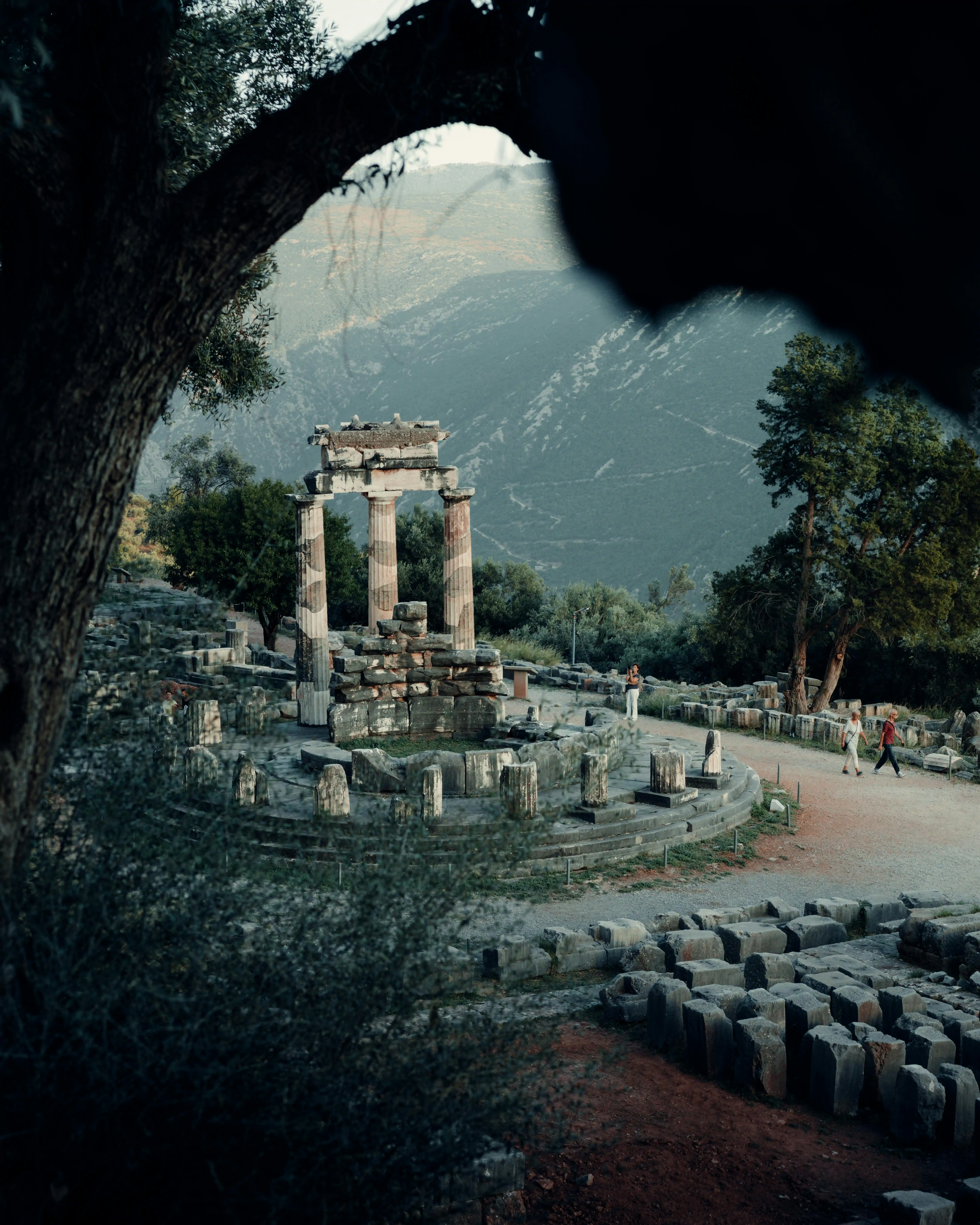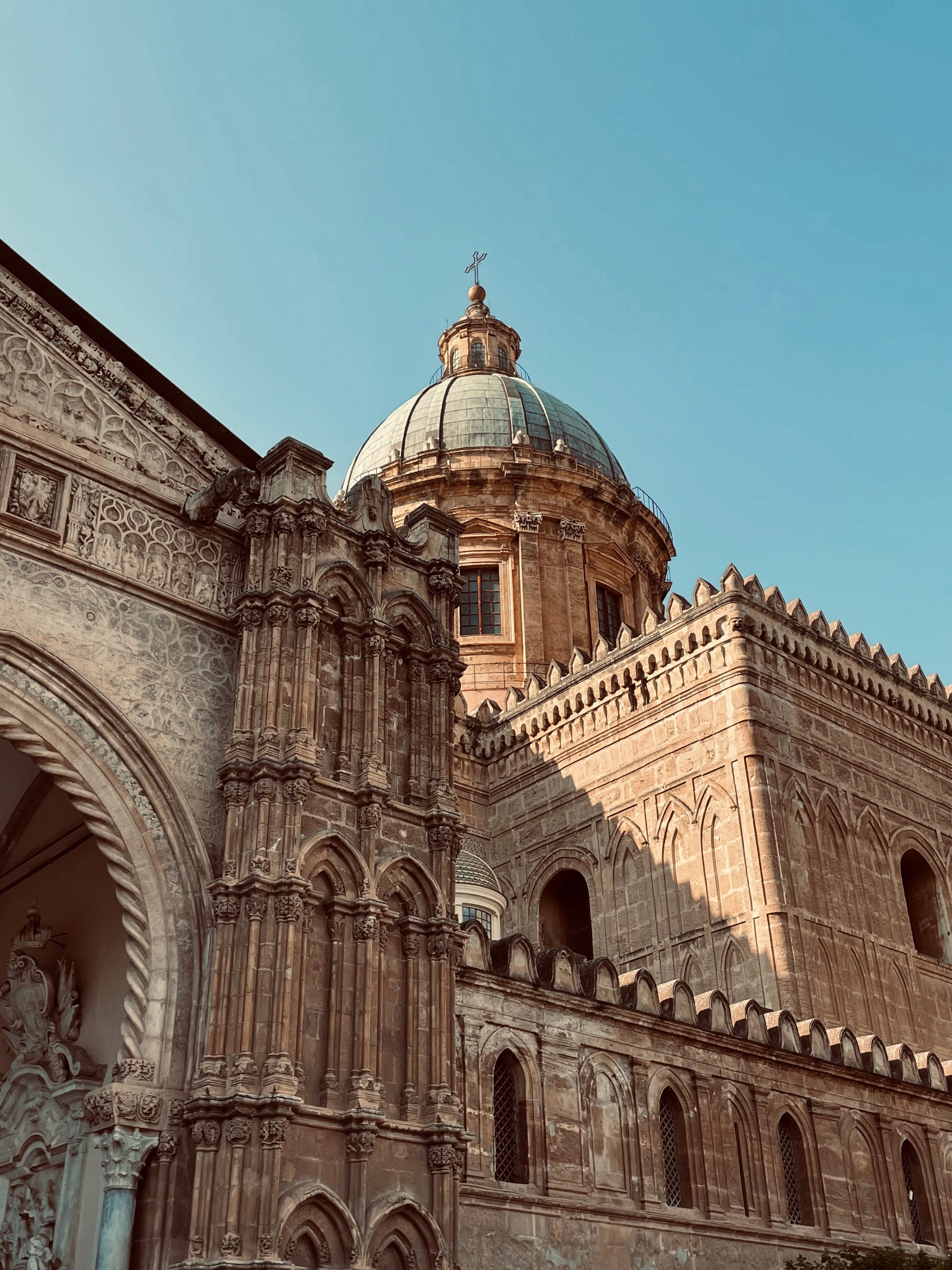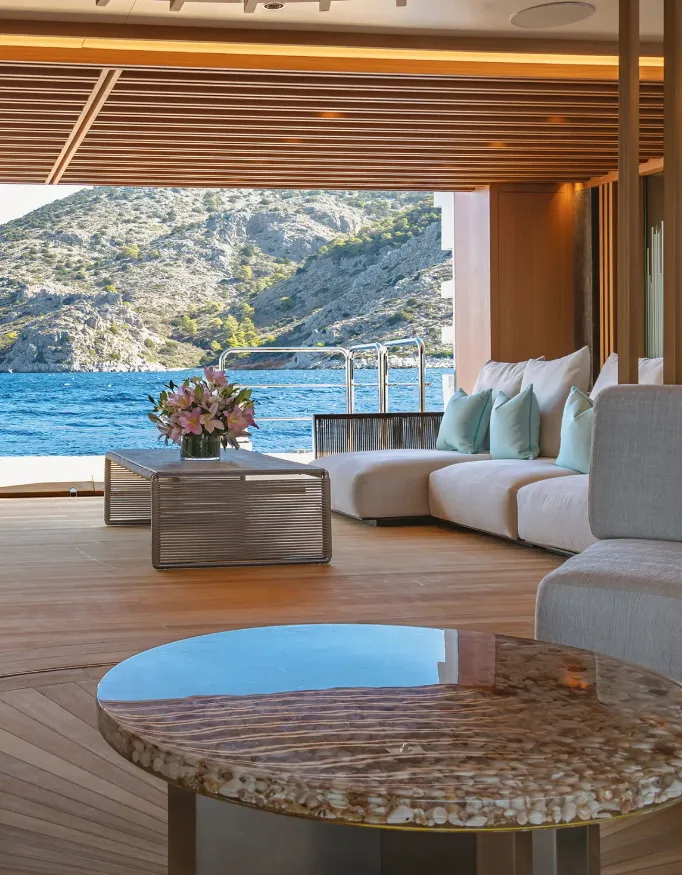Greece Country Guide.

Coastline. 13.676 km of coastline in Greece.

Sun hours. More than 3.000 sun hours every year.

Best time to visit. The best time to visit is April to June or September to mid-October, with mild weather and fewer crowds.

Must see. The Acropolis and Parthenon, Knossos Palace, Delphi, Rhodes, and much more ...
Must knowns about Greece.
Dive into the essence of Greece. From its stunning landscapes and rich history to its vibrant culture and dynamic economy, this section paints a vivid picture of what makes this nation unique. Explore the heart and soul of Greece, where every detail tells a story of tradition, innovation, and resilience.
Greece.
Greece is a mesmerizing blend of ancient history and stunning natural beauty, where crystal-clear waters meet rugged coastlines and sun-drenched islands.
The iconic ruins of Athens, like the Parthenon, echo the country’s rich cultural heritage, while the whitewashed villages of Santorini and Mykonos offer postcard-perfect views.
Greece's diverse landscapes range from the mountainous terrains of the Peloponnese to the serene beaches of Crete, making it a haven for both adventure seekers and those seeking relaxation.
Greek cuisine is a celebration of fresh, local ingredients, with dishes like moussaka, tzatziki, and grilled seafood embodying the essence of Mediterranean gastronomy.
Whether exploring ancient ruins, savoring a seaside meal, or simply basking in the Aegean sun, Greece offers an unforgettable experience.
Visa requirements.
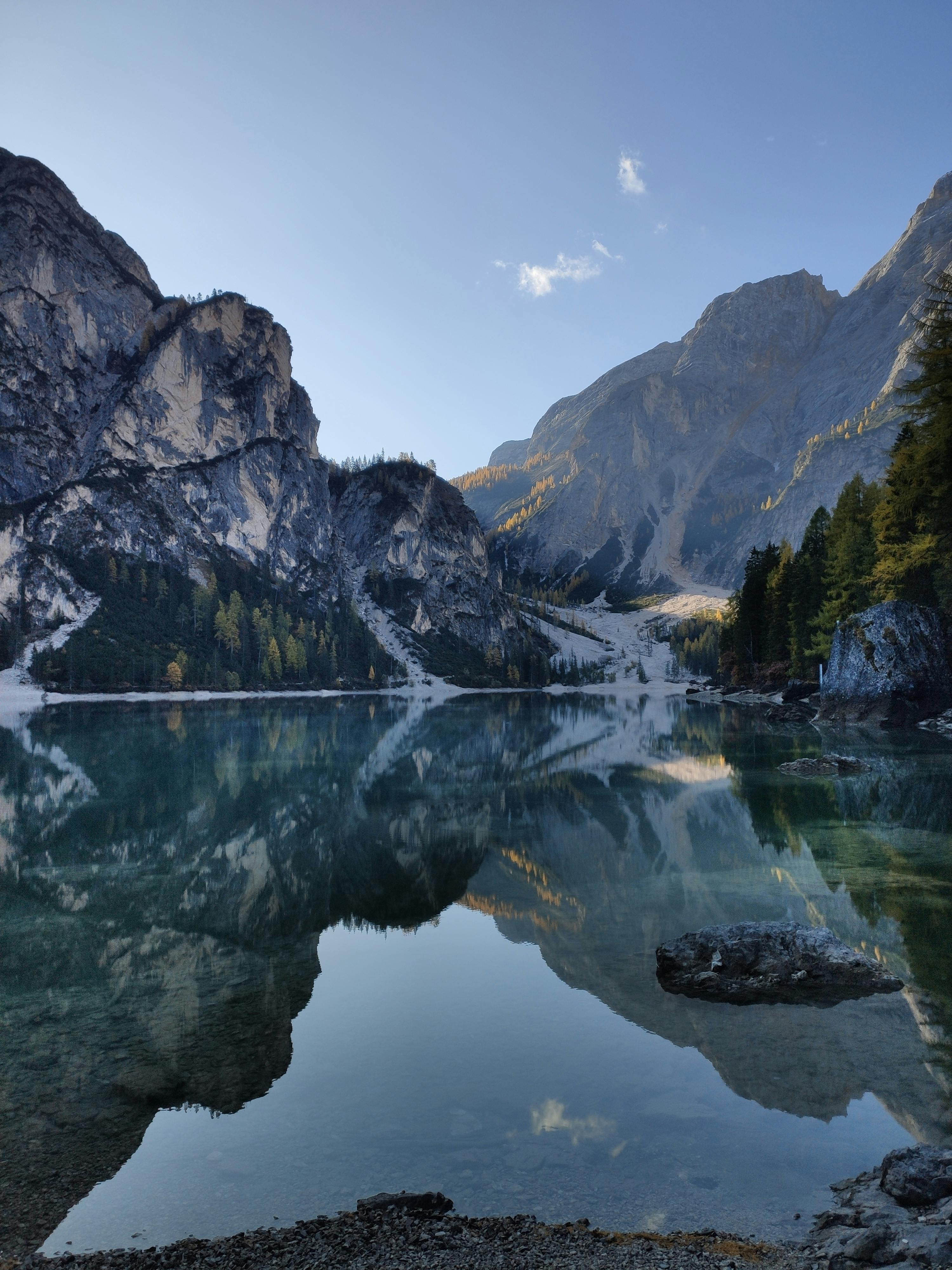
Short-Stay Visas (Schengen Visas).
These visas allow for stays of up to 90 days within a 180-day period for purposes such as tourism, business, visiting family or friends, or attending conferences.
Who Needs a Schengen Visa?
- Non-EU/EEA/Swiss Nationals: Most non-EU/EEA/Swiss nationals need a Schengen visa to enter Greece.
- Visa-Exempt Countries: Nationals from certain countries, such as the United States, Canada, Australia, New Zealand, Japan, and most South American countries, do not need a visa for short stays of up to 90 days within a 180-day period.
Requirements:
- Application Form: Completed and signed.
- Passport: Must be valid for at least three months beyond the intended departure date from the Schengen Area and must have been issued within the last 10 years. It should also have at least two blank pages.
- Photographs: Two recent passport-sized photos that meet the Schengen photo requirements.
- Travel Insurance: Medical travel insurance covering at least €30,000 for medical emergencies, hospitalization, and repatriation, valid throughout the Schengen Area.
- Proof of Accommodation: Hotel reservations, an invitation letter from a host, or other evidence of accommodation.
- Proof of Financial Means: Bank statements, proof of employment, or a sponsorship letter showing sufficient funds for the stay (generally about €50-70 per day).
- Flight Itinerary: Round-trip or onward flight reservations.
- Supporting Documents: Depending on the visit's purpose, you might need an invitation letter, conference registration, or business correspondence.
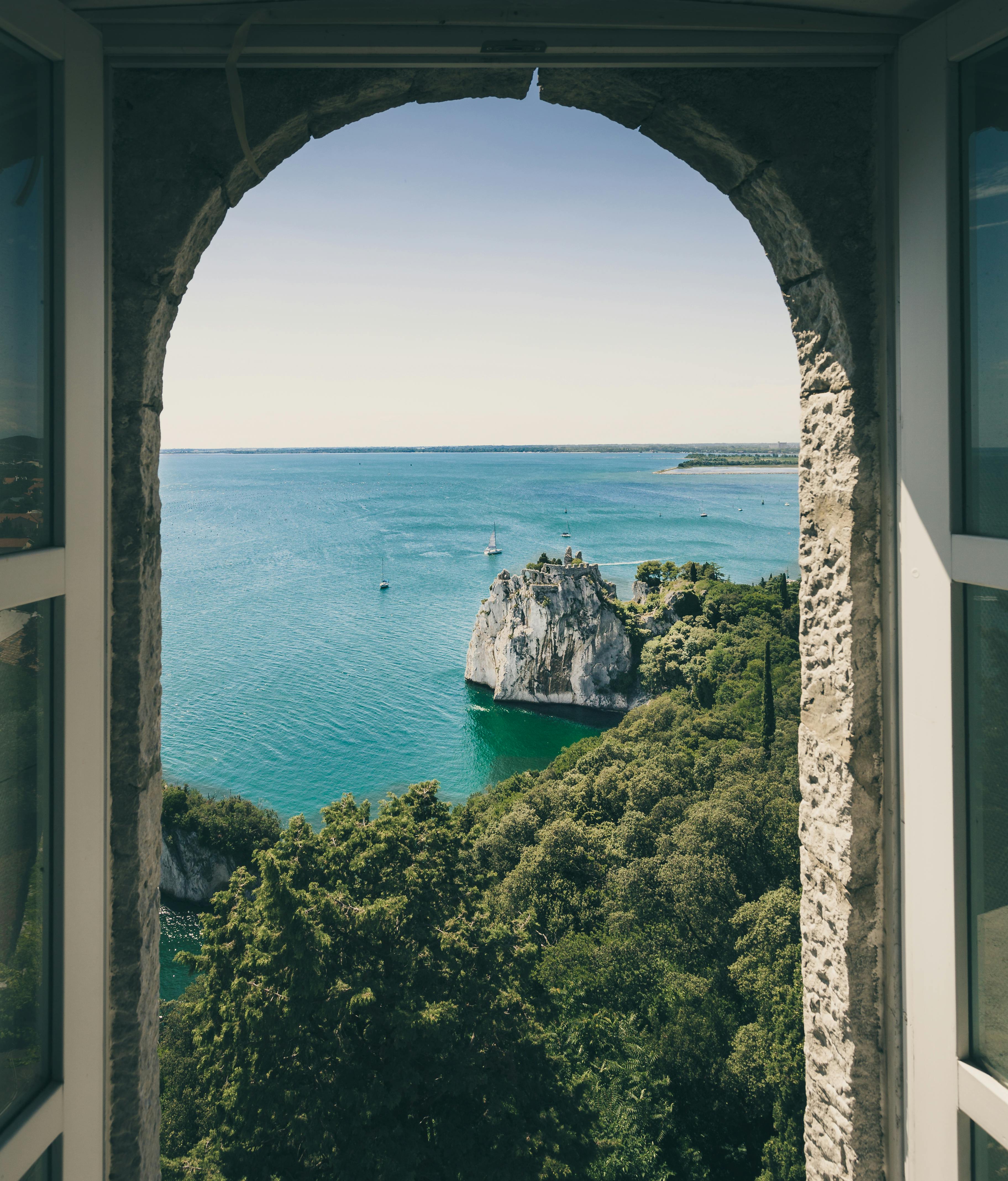
Long-Stay Visas (National Visas).
These visas are for stays longer than 90 days and are required for purposes such as work, study, family reunification, or residency.
Who Needs a National Visa?
- Non-EU/EEA/Swiss nationals planning to stay in Greece for more than 90 days for any purpose.
Requirements:
- Application Form: Completed and signed.
- Passport: Valid for at least three months beyond the intended stay, with at least two blank pages.
- Photographs: Two recent passport-sized photos.
- Proof of Financial Means: Evidence of sufficient financial resources to cover the stay, such as bank statements, proof of employment, or a scholarship.
- Proof of Accommodation: Rental agreement, proof of housing in Greece, or confirmation from a Greek institution.
- Health Insurance: Proof of adequate health insurance coverage.
- Purpose-Specific Documents:
- Work Visa: An employment contract or work permit approved by Greek authorities.
- Student Visa: An enrollment letter from a recognized Greek educational institution.
- Family Reunification: Proof of family ties (e.g., marriage or birth certificates) and proof of residency of the family member in Greece.
- Language Proficiency: For study or work visas, proof of Greek language proficiency might be required, depending on the institution or employer.
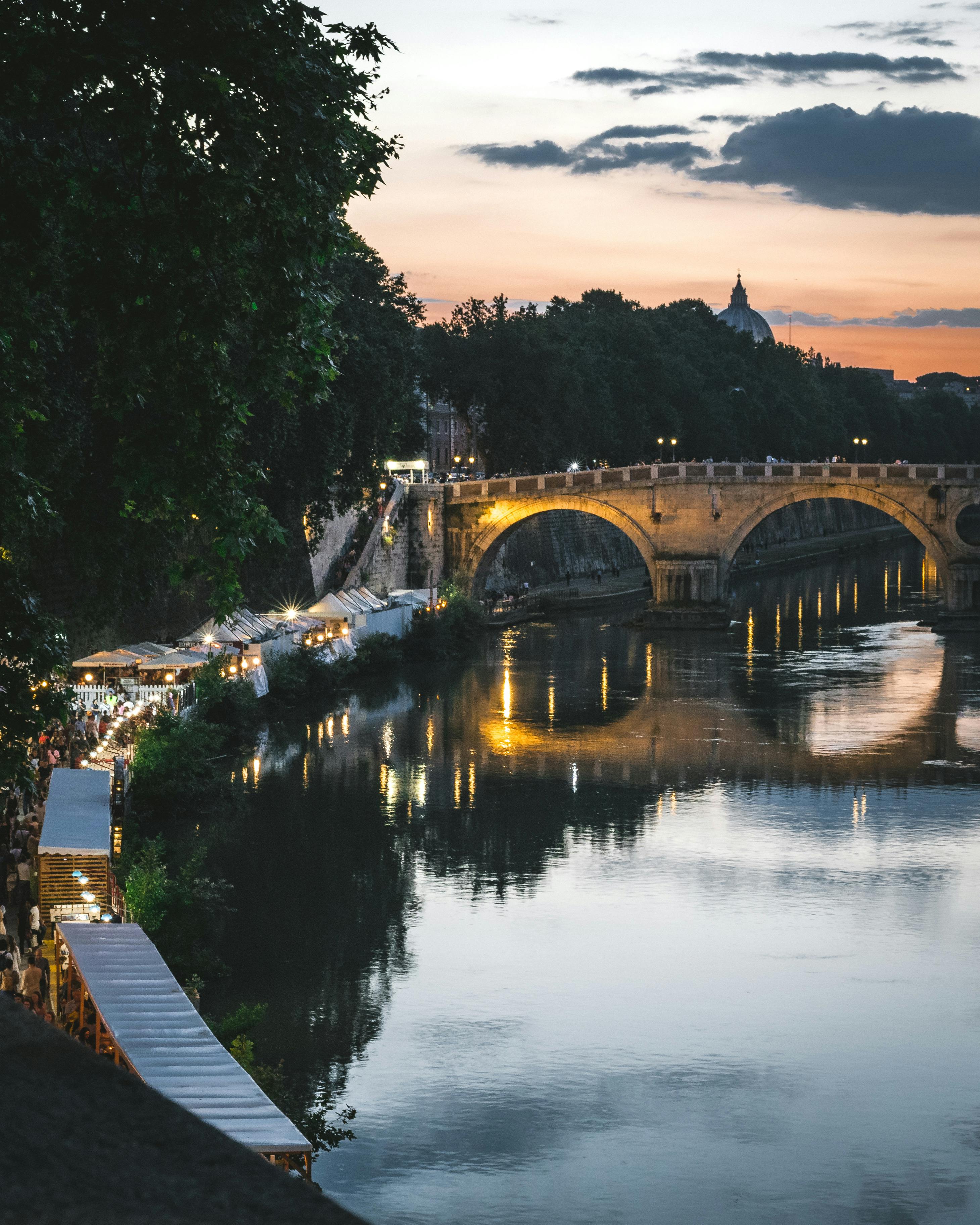
Transit Visas.
This visa is for certain nationalities who need to pass through a Greek airport while en route to a non-Schengen destination.
Who Needs a Transit Visa?
- Nationals of specific countries, such as Afghanistan, Bangladesh, Congo, Eritrea, Ethiopia, Ghana, Iran, Iraq, Nigeria, Pakistan, Somalia, Sri Lanka, and Syria, may require an airport transit visa.
Requirements:
- Application Form: Completed and signed.
- Passport: Valid with at least one blank page.
- Photographs: One or two recent passport-sized photos.
- Flight Ticket: Proof of the onward flight to the final destination.
- Visa for Next Destination: If required, the visa for the final destination.
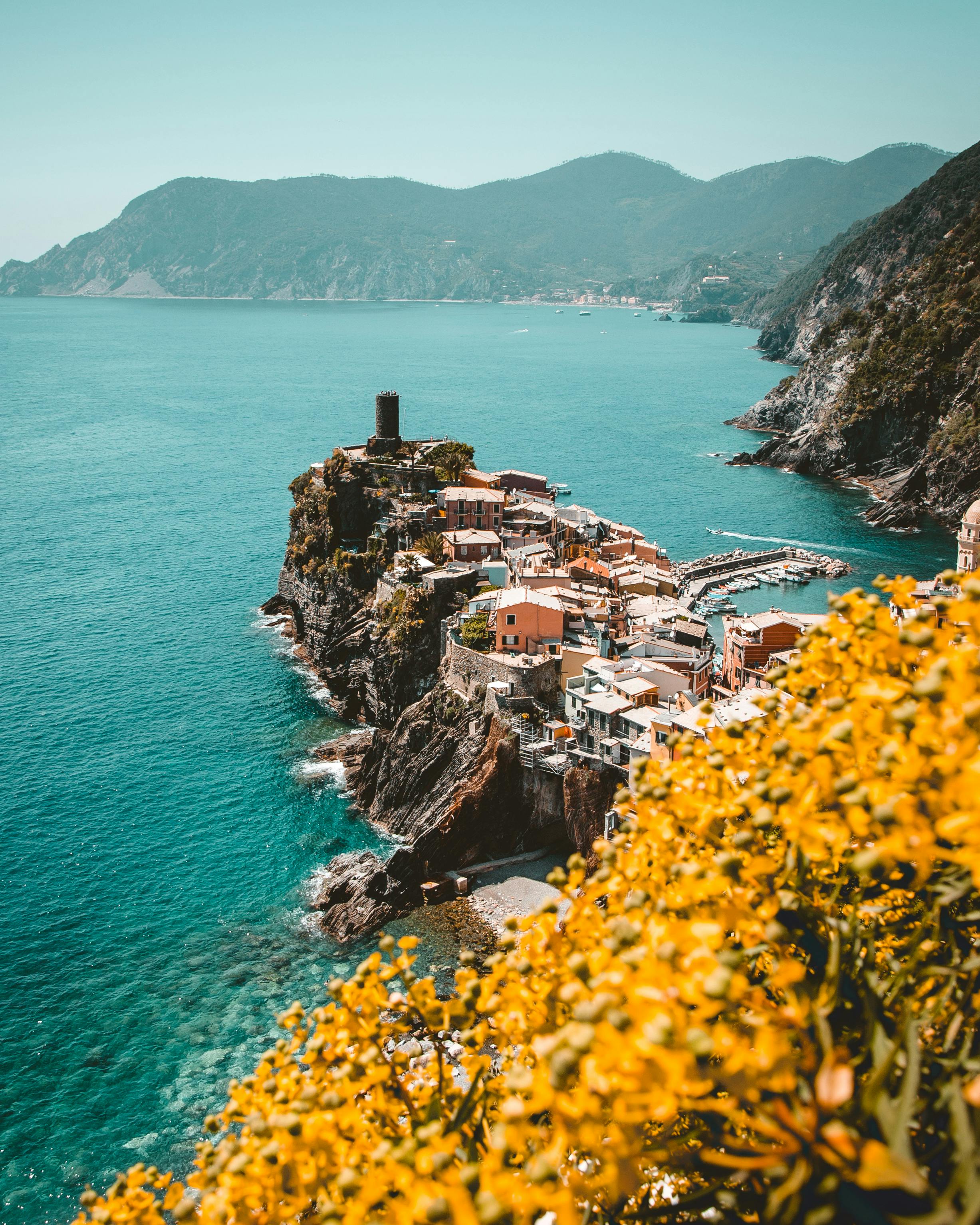
Special Cases.
EU/EEA/Swiss Nationals: These citizens do not need a visa to enter, reside, work, or study in Greece.
Family Members of EU/EEA/Swiss Nationals: Depending on their nationality, they may need to apply for a visa or can benefit from simplified visa procedures.
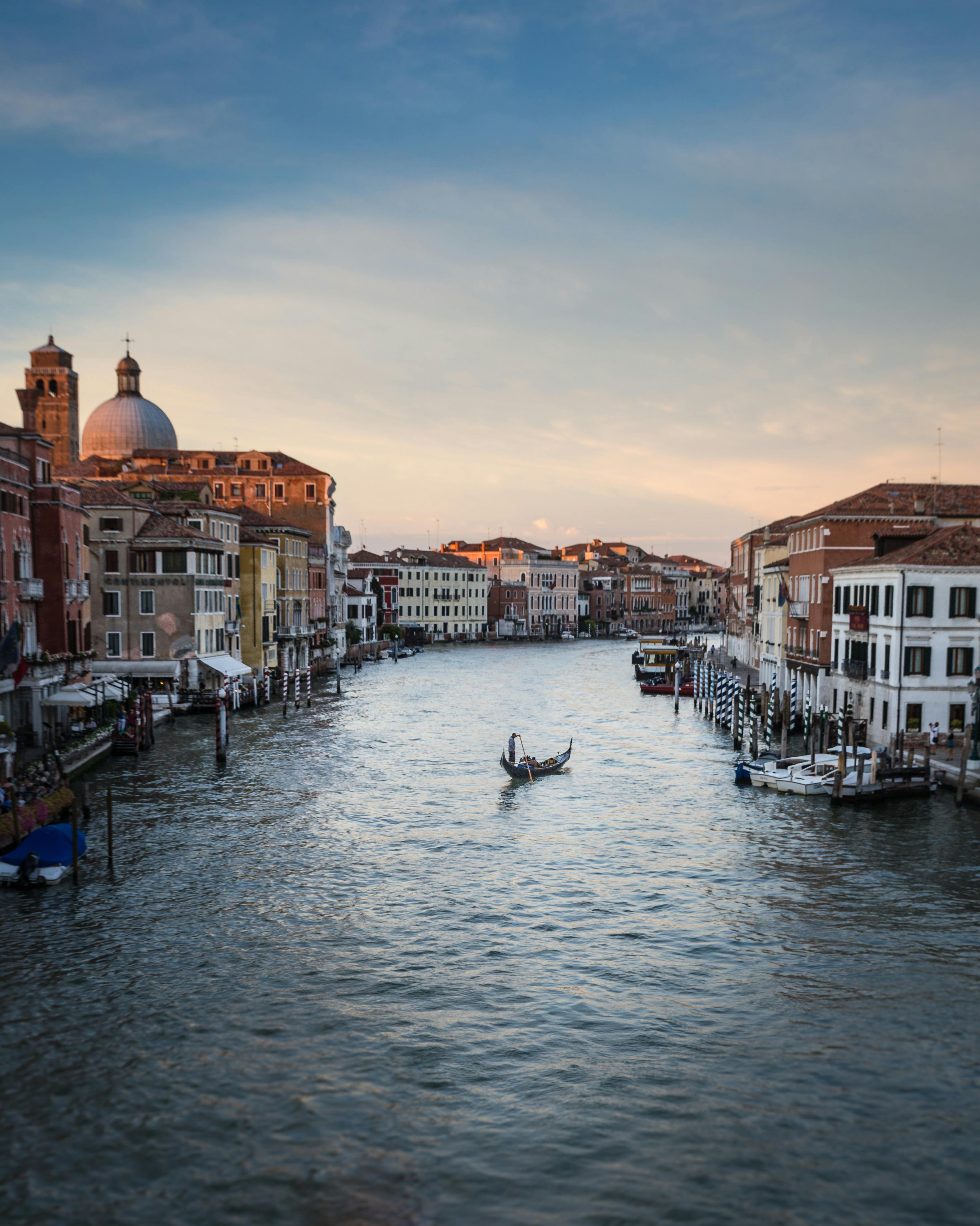
Application Process.
- Determine the Visa Type: Based on the purpose and duration of the stay.
- Gather Required Documents: According to the visa type.
- Complete the Application Form: Available online or at the Greek consulate/embassy.
- Schedule an Appointment: At the nearest Greek consulate/embassy or visa application center.
- Submit the Application: In person, along with biometric data (fingerprints and photo).
- Pay the Visa Fee: Payment varies based on the type of visa.
- Wait for Processing: Schengen visas typically take around 15 calendar days, while long-stay visas can take longer.
- Collect the Visa: Once approved, collect the visa from the consulate/embassy or visa application center.
Additional Notes.
- Multiple Entry Visa: For those needing to travel to Greece multiple times within a short period, a multiple-entry Schengen visa may be requested.
- Visa Extensions: Generally, Schengen visas cannot be extended beyond 90 days except in extraordinary circumstances. Long-stay visas can sometimes be extended depending on the situation.
It is crucial to check with the specific Greek consulate or embassy in your country for up-to-date information and specific requirements, as they can vary.
Safety in Italy.

General Safety.
- Low Violent Crime Rate: Greece generally has a low rate of violent crime. Incidents involving tourists are rare, making it a safe destination for travelers.
- Petty Crime: Petty crime, such as pickpocketing and bag snatching, can occur in busy tourist areas, particularly in Athens, on public transportation, and at popular tourist sites like the Acropolis. Be mindful of your belongings, especially in crowded places.
- Scams: Common scams include overcharging by taxi drivers or restaurants and street vendors selling fake goods. Always use reputable services and double-check prices before purchasing.

Health and Medical Care.
- Healthcare System: Greece has a good healthcare system, with public and private hospitals available. EU citizens can use their European Health Insurance Card (EHIC) for medical care. Non-EU citizens should have travel insurance to cover health emergencies.
- Pharmacies: Pharmacies are widely available, especially in urban areas. Pharmacists in Greece are well-trained and can offer advice and over-the-counter medications.
- Vaccinations: No special vaccinations are required for travel to Greece, but routine vaccinations should be up to date.

Natural Hazards.
- Earthquakes: Greece is located in a seismically active region, and minor earthquakes are common. Most are not dangerous, but it’s good to be aware of earthquake safety procedures, especially in areas like Crete, the Dodecanese, and the Ionian Islands.
- Wildfires: Greece experiences wildfires, particularly during the hot, dry summer months. If you’re visiting during this time, stay informed about local conditions and follow any evacuation orders.
- Heatwaves: Summer in Greece can be very hot, with temperatures sometimes exceeding 40°C (104°F). Stay hydrated, wear sunscreen, and avoid outdoor activities during peak heat hours.

Transportation Safety.
- Road Safety: Greece has a relatively high rate of traffic accidents. Be cautious when driving, especially on narrow or winding roads common on the islands. Driving in Athens can be particularly challenging due to heavy traffic.
- Public Transportation: Public transportation in Greece is generally safe. However, be aware of pickpockets, especially in crowded areas like buses, trains, and the metro in Athens.
- Taxis: Use licensed taxis with meters to avoid overcharging. In some areas, it’s common for taxi drivers to pick up multiple passengers, so don’t be surprised if others join your ride.
- Ferries and Boats: Greece has an extensive network of ferries connecting the mainland with the islands. These are generally safe and reliable, but check the weather conditions before traveling, as rough seas can cause delays or cancellations.

Cultural Considerations.
- Respect for Local Customs: Greeks are generally friendly and hospitable. It’s important to respect local customs and traditions, especially in more rural areas. Dress modestly when visiting churches or monasteries.
- Language Barrier: English is widely accepted and spoken in Greece. To bolster your experience you can learn some Greek sentences.

Emergency Contacts.
- Police: 100
- Ambulance: 166
- Fire Brigade: 199
- European Emergency Number (for all services): 112
Must-sees in Greece.
Prepare to embark on a journey through the most captivating and essential sites Greece has to offer. From majestic natural landscapes to historic marvels, these locations are the very heart and soul of Greece's allure.
Regions in Greece.
From the azure coastlines of the Aegean to the rugged peaks of the Pindus Mountains, Greece unfolds a captivating mosaic of landscapes that offer something for every traveler. Imagine a land where ancient olive groves meet vibrant cities, where serene islands contrast with lively villages nestled in verdant valleys. Each region tells its own story, shaped by a unique blend of culture, history, and natural beauty. Discover the places that define this country's rich tapestry and uncover the many layers that make Greece an extraordinary destination.

Attica.
Florence.
Florence, a Renaissance jewel, dazzles with Michelangelo’s David, the Duomo, and art in the Uffizi Gallery, all set in charming, historic streets.
Val d’Orcia.
Val d’Orcia, a scenic Tuscan valley, delights with rolling hills, medieval towns, and fine wines, showcasing Italy’s serene rural charm.
Cascate del Mulino.
Cascate del Mulino features enchanting natural hot springs cascading into picturesque pools, offering a tranquil retreat amid stunning countryside.
Attica, the beating heart of Greece, offers luxury travelers a blend of ancient grandeur and modern sophistication. Home to Athens, the cradle of Western civilization, this region is a treasure trove of cultural wonders, from the iconic Acropolis crowned by the Parthenon to the vibrant neighborhoods of Plaka and Monastiraki, where centuries-old charm meets cosmopolitan flair.
With over 300 days of sunshine, a Mediterranean climate ensures mild winters and warm summers, ideal for exploring Attica’s diverse offerings.
Savor world-class cuisine in seaside tavernas along the Athenian Riviera, or indulge in high-end shopping at Kolonaki's boutique stores.
The region's unique coastline, dotted with secluded coves and luxurious resorts, offers a tranquil escape, while nearby islands like Hydra and Aegina provide a taste of authentic Greek island life.
Rich in history, culture, and natural beauty, Attica invites you to experience Greece at its most refined, where every corner promises a new discovery.
Attica.
Sadly we are not able to show you all activities. But let the three activities below give you a small tip and insight in what is possible.
Get in contact with us to discover more about what is possible.

Central Greece.
Florence.
Florence, a Renaissance jewel, dazzles with Michelangelo’s David, the Duomo, and art in the Uffizi Gallery, all set in charming, historic streets.
Val d’Orcia.
Val d’Orcia, a scenic Tuscan valley, delights with rolling hills, medieval towns, and fine wines, showcasing Italy’s serene rural charm.
Cascate del Mulino.
Cascate del Mulino features enchanting natural hot springs cascading into picturesque pools, offering a tranquil retreat amid stunning countryside.
Central Greece, a region where ancient myth meets modern luxury, offers an exquisite mix of natural wonders and cultural treasures.
From the UNESCO World Heritage site of Delphi, once the center of the world for ancient Greeks, to the picturesque town of Arachova, known as the “Mykonos of winter,” this region is full of must-see attractions that captivate the discerning traveler.
The area boasts a varied climate, with warm summers perfect for exploring the historic cities and cooler winters ideal for skiing on Mount Parnassus. Central Greece is also home to the striking Meteora monasteries, perched precariously atop towering rock formations, offering both spiritual and visual delight.
Indulge in local delicacies such as tsipouro and freshly caught seafood, or unwind in the natural thermal springs of Edipsos.
With its unique blend of mountainous landscapes, lush valleys, and coastal charm, Central Greece is a destination that seamlessly combines adventure, culture, and luxury.
Central Greece activities.
Sadly we are not able to show you all activities. But let the three activities below give you a small tip and insight in what is possible.
Get in contact with us to discover more about what is possible.

Central Macedonia.
Florence.
Florence, a Renaissance jewel, dazzles with Michelangelo’s David, the Duomo, and art in the Uffizi Gallery, all set in charming, historic streets.
Val d’Orcia.
Val d’Orcia, a scenic Tuscan valley, delights with rolling hills, medieval towns, and fine wines, showcasing Italy’s serene rural charm.
Cascate del Mulino.
Cascate del Mulino features enchanting natural hot springs cascading into picturesque pools, offering a tranquil retreat amid stunning countryside.
Central Macedonia, a region where vibrant history and natural splendor converge, is an ideal destination for travelers seeking a blend of culture, relaxation, and adventure. Home to Thessaloniki, Greece's second-largest city, Central Macedonia offers an array of experiences, from exploring Byzantine churches and Ottoman architecture to indulging in gourmet cuisine along the bustling waterfront.
The region’s climate is typically Mediterranean, with hot, dry summers and mild winters, making it perfect for year-round exploration.
Discover the stunning landscapes of Halkidiki, with its three-pronged peninsula boasting golden beaches, crystal-clear waters, and secluded coves. Visit Mount Olympus, the legendary home of the Greek gods, where exclusive guided treks reveal breathtaking vistas and ancient mythology. Explore the Royal Tombs of Vergina, the final resting place of King Philip II, father of Alexander the Great.
With its diverse offerings—from cosmopolitan city life to serene coastal retreats—Central Macedonia invites you to uncover Greece’s rich heritage and natural beauty.
Central Macedonia activities.
Sadly we are not able to show you all activities. But let the three activities below give you a small tip and insight in what is possible.
Get in contact with us to discover more about what is possible.

Crete.
Florence.
Florence, a Renaissance jewel, dazzles with Michelangelo’s David, the Duomo, and art in the Uffizi Gallery, all set in charming, historic streets.
Val d’Orcia.
Val d’Orcia, a scenic Tuscan valley, delights with rolling hills, medieval towns, and fine wines, showcasing Italy’s serene rural charm.
Cascate del Mulino.
Cascate del Mulino features enchanting natural hot springs cascading into picturesque pools, offering a tranquil retreat amid stunning countryside.
Crete, the largest of the Greek islands, offers a luxurious blend of ancient history, vibrant culture, and stunning natural landscapes. From the palatial ruins of Knossos, the heart of the Minoan civilization, to the charming Venetian harbor of Chania, Crete is a destination where timeless heritage meets modern elegance.
The island enjoys a Mediterranean climate with hot, dry summers and mild winters, making it an ideal year-round escape.
Explore the dramatic Samaria Gorge, Europe’s longest gorge, perfect for a private guided trek, or relax on the pristine sands of Elafonissi Beach, renowned for its pink-tinged shores.
Savor the island's famed Cretan cuisine, known for its fresh, local ingredients like wild herbs, honey, and olive oil, in world-class seaside restaurants.
With its diverse regions, including the mountainous Rethymno and the tranquil Lasithi plateau, Crete offers an unparalleled mix of adventure, relaxation, and culture, ensuring every moment is filled with discovery and delight.
Crete activities.
Sadly we are not able to show you all activities. But let the three activities below give you a small tip and insight in what is possible.
Get in contact with us to discover more about what is possible.

Eastern Macedonia and Thrace.
Florence.
Florence, a Renaissance jewel, dazzles with Michelangelo’s David, the Duomo, and art in the Uffizi Gallery, all set in charming, historic streets.
Val d’Orcia.
Val d’Orcia, a scenic Tuscan valley, delights with rolling hills, medieval towns, and fine wines, showcasing Italy’s serene rural charm.
Cascate del Mulino.
Cascate del Mulino features enchanting natural hot springs cascading into picturesque pools, offering a tranquil retreat amid stunning countryside.
Eastern Macedonia and Thrace, a region where Europe meets Asia, offers luxury travelers an experience rich in diverse landscapes, cultures, and traditions. Stretching from the Aegean Sea to the lush Rhodope Mountains, this area boasts a unique mix of pristine beaches, verdant forests, and vibrant towns.
The climate varies from mild coastal weather to cooler mountain breezes, making it ideal for year-round exploration.
Discover the ancient city of Philippi, a UNESCO World Heritage site where you can walk in the footsteps of the Apostle Paul, or explore the tranquil beauty of Lake Kerkini, a birdwatcher’s paradise known for its rare species.
The region’s rich cultural mosaic is reflected in its cuisine, blending Greek, Ottoman, and Balkan influences, with delicacies like kavourmas and sweet kazan dibi.
From the lively port city of Kavala with its Ottoman-era aqueduct to the scenic vineyards of Drama, Eastern Macedonia and Thrace invites you to experience Greece’s lesser-known treasures in style and comfort.
Eastern Macedonia and Thrace.
Sadly we are not able to show you all activities. But let the three activities below give you a small tip and insight in what is possible.
Get in contact with us to discover more about what is possible.

Epirus.
Florence.
Florence, a Renaissance jewel, dazzles with Michelangelo’s David, the Duomo, and art in the Uffizi Gallery, all set in charming, historic streets.
Val d’Orcia.
Val d’Orcia, a scenic Tuscan valley, delights with rolling hills, medieval towns, and fine wines, showcasing Italy’s serene rural charm.
Cascate del Mulino.
Cascate del Mulino features enchanting natural hot springs cascading into picturesque pools, offering a tranquil retreat amid stunning countryside.
Epirus, nestled between the Pindus Mountains and the Ionian Sea, is a land of rugged beauty and hidden treasures, perfect for luxury travelers seeking an off-the-beaten-path experience. Known for its dramatic landscapes, Epirus boasts lush forests, deep gorges, and pristine rivers.
The region’s climate ranges from cool, refreshing mountain air to mild coastal breezes, making it ideal for outdoor adventures year-round.
Discover the stunning Vikos Gorge, one of the world’s deepest canyons, perfect for a private guided hike through its awe-inspiring rock formations. Explore the ancient theater of Dodoni, one of Greece’s oldest and most significant archaeological sites, where mythology and history intertwine. The picturesque town of Ioannina, set on the shores of Lake Pamvotis, offers a blend of Ottoman architecture, vibrant markets, and exclusive boat tours to its small island.
Epirus combines natural splendor, rich cultural heritage, and authentic luxury, inviting travelers to experience Greece’s wild, untouched side in an unparalleled setting.
Epirus activities.
Sadly we are not able to show you all activities. But let the three activities below give you a small tip and insight in what is possible.
Get in contact with us to discover more about what is possible.

Ionian Islands.
Florence.
Florence, a Renaissance jewel, dazzles with Michelangelo’s David, the Duomo, and art in the Uffizi Gallery, all set in charming, historic streets.
Val d’Orcia.
Val d’Orcia, a scenic Tuscan valley, delights with rolling hills, medieval towns, and fine wines, showcasing Italy’s serene rural charm.
Cascate del Mulino.
Cascate del Mulino features enchanting natural hot springs cascading into picturesque pools, offering a tranquil retreat amid stunning countryside.
The Ionian Islands, a stunning archipelago off Greece’s western coast, captivate travelers with their lush landscapes, turquoise waters, and rich Venetian heritage.
Known for their mild Mediterranean climate, these islands offer warm, sun-soaked summers and gentle winters, making them a year-round destination.
Each island boasts its unique charm: Corfu enchants with its UNESCO-listed Old Town, a blend of Venetian, French, and British influences set against a backdrop of olive groves and crystal-clear coves.
Kefalonia impresses with dramatic landscapes like the striking Myrtos Beach, nestled between towering limestone cliffs, and the mystical underground Melissani Cave.
Zakynthos is famed for Navagio Beach, also known as Shipwreck Beach, a secluded cove with dazzling white sands and electric-blue waters. Meanwhile, Lefkada's rugged coastline and hidden bays are a paradise for sailing enthusiasts.
The Ionian Islands stand out with their vibrant cultural mix, luxurious yachting opportunities, and breathtaking natural beauty, inviting discerning travelers to explore Greece’s most verdant and diverse shores.
Ionian Islands activities.
Sadly we are not able to show you all activities. But let the three activities below give you a small tip and insight in what is possible.
Get in contact with us to discover more about what is possible.

North Aegean.
Florence.
Florence, a Renaissance jewel, dazzles with Michelangelo’s David, the Duomo, and art in the Uffizi Gallery, all set in charming, historic streets.
Val d’Orcia.
Val d’Orcia, a scenic Tuscan valley, delights with rolling hills, medieval towns, and fine wines, showcasing Italy’s serene rural charm.
Cascate del Mulino.
Cascate del Mulino features enchanting natural hot springs cascading into picturesque pools, offering a tranquil retreat amid stunning countryside.
The North Aegean islands offer a captivating blend of untouched nature, ancient history, and authentic Greek charm, ideal for luxury travelers seeking tranquility away from the usual tourist routes.
This region, bathed in the warm Mediterranean sun, features a diverse climate with mild winters and hot summers, perfect for year-round exploration.
Each island boasts its unique allure: Lesvos is famed for its olive groves, historic Mytilene Castle, and the Petrified Forest, a rare natural monument millions of years old. Chios, known as the “Mastic Island,” offers exclusive experiences like visiting the medieval mastic villages of Pyrgi and Mesta, where the air is filled with the scent of resin from mastic trees found nowhere else in the world. Samos enchants with its verdant landscapes, vineyards, and ancient sites like the Heraion, a grand sanctuary dedicated to Hera.
With secluded beaches, therapeutic hot springs, and rich culinary traditions, the North Aegean islands invite discerning travelers to discover Greece’s hidden gems in style.
North Aegean activities.
Sadly we are not able to show you all activities. But let the three activities below give you a small tip and insight in what is possible.
Get in contact with us to discover more about what is possible.

Peloponnese.
Florence.
Florence, a Renaissance jewel, dazzles with Michelangelo’s David, the Duomo, and art in the Uffizi Gallery, all set in charming, historic streets.
Val d’Orcia.
Val d’Orcia, a scenic Tuscan valley, delights with rolling hills, medieval towns, and fine wines, showcasing Italy’s serene rural charm.
Cascate del Mulino.
Cascate del Mulino features enchanting natural hot springs cascading into picturesque pools, offering a tranquil retreat amid stunning countryside.
The Peloponnese Peninsula, a jewel in southern Greece, beckons luxury travelers with its captivating blend of ancient history, stunning landscapes, and opulent retreats.
This picturesque region, surrounded by crystal-clear Mediterranean waters, offers a mild climate perfect for year-round exploration.
Wander through the ancient ruins of Olympia, the birthplace of the Olympic Games, or marvel at the medieval charm of Mystras, a UNESCO World Heritage Site.
The Peloponnese is renowned for its diverse offerings—from the luxurious seaside resorts of Costa Navarino to the serene beauty of the Mani Peninsula.
Enjoy world-class dining in Nafplio, explore the Venetian architecture in Kalamata, or savor wine tasting in the renowned vineyards of Nemea.
Each corner of the Peloponnese presents a unique tapestry of history, culture, and natural beauty, ensuring an unforgettable luxury escape.
Peloponnese activities.
Sadly we are not able to show you all activities. But let the three activities below give you a small tip and insight in what is possible.
Get in contact with us to discover more about what is possible.

South Aegean.
Florence.
Florence, a Renaissance jewel, dazzles with Michelangelo’s David, the Duomo, and art in the Uffizi Gallery, all set in charming, historic streets.
Val d’Orcia.
Val d’Orcia, a scenic Tuscan valley, delights with rolling hills, medieval towns, and fine wines, showcasing Italy’s serene rural charm.
Cascate del Mulino.
Cascate del Mulino features enchanting natural hot springs cascading into picturesque pools, offering a tranquil retreat amid stunning countryside.
The South Aegean region, a dazzling expanse of islands in Greece, offers a paradise of crystal-clear waters, sun-drenched landscapes, and rich cultural heritage.
Comprising iconic islands like Santorini, Mykonos, and Rhodes, this area is celebrated for its stunning scenery, luxurious resorts, and vibrant nightlife.
The climate is typically Mediterranean, with warm, sunny summers and mild winters, perfect for year-round exploration.
Wander through the whitewashed buildings of Santorini with its breathtaking caldera views, or immerse yourself in the lively ambiance of Mykonos’ beach clubs and historic sites. Rhodes, with its medieval Old Town and ancient ruins, provides a blend of historical intrigue and beachside relaxation.
Unique selling points include exclusive private yacht charters, world-class spa retreats, and the opportunity to explore hidden coves and ancient ruins that add a touch of luxury to every visit.
South Aegean activities.
Sadly we are not able to show you all activities. But let the three activities below give you a small tip and insight in what is possible.
Get in contact with us to discover more about what is possible.

Western Greece.
Florence.
Florence, a Renaissance jewel, dazzles with Michelangelo’s David, the Duomo, and art in the Uffizi Gallery, all set in charming, historic streets.
Val d’Orcia.
Val d’Orcia, a scenic Tuscan valley, delights with rolling hills, medieval towns, and fine wines, showcasing Italy’s serene rural charm.
Cascate del Mulino.
Cascate del Mulino features enchanting natural hot springs cascading into picturesque pools, offering a tranquil retreat amid stunning countryside.
Western Greece, a captivating blend of untouched nature and ancient heritage, offers an escape into one of the country’s most diverse landscapes.
Stretching from the Ionian Sea to the mountains of Epirus, this region boasts a mild Mediterranean climate, with warm summers and mild winters ideal for year-round exploration.
Visitors can marvel at the ancient ruins of Nikopolis, wander through the lush wetlands of the Messolonghi Lagoon, or explore the stunning beaches of Lefkada and Zakynthos, where turquoise waters meet pristine sands. The region is also home to the majestic Panachaiko Mountains, perfect for hiking with panoramic sea views.
Western Greece uniquely combines authentic cultural experiences, such as visiting traditional villages and sampling local delicacies, with modern luxury through private yacht charters, exclusive archaeological tours, and high-end wine tastings in Achaea.
With its blend of natural beauty, history, and luxury, Western Greece offers a distinctive getaway unlike any other in the country.
Western Greece activities.
Sadly we are not able to show you all activities. But let the three activities below give you a small tip and insight in what is possible.
Get in contact with us to discover more about what is possible.
Gastronomy in Greece.
Explore the culinary delights of France, where you'll find famous recipes, top restaurants, and celebrated chefs. This guide offers a taste of the nation’s rich food culture, but remember, there’s a whole world of flavors and dining experiences beyond these highlights. Dive in and let your palate and eyes discover famous recipes, top restaurants, and celebrated chefs.
Famous dishes.

Moussaka.
Moussaka is a quintessential Greek dish that layers sautéed eggplant, spiced ground beef, and a rich béchamel sauce. Baked until golden and bubbling, this hearty casserole features bold flavors of cinnamon, nutmeg, and cloves, creating a comforting and savory experience that represents Greek cuisine at its finest.

Souvlaki.
Souvlaki is a beloved Greek street food that consists of marinated pieces of pork, chicken, or lamb skewered and grilled to perfection. Served with warm pita bread, fresh vegetables, and tzatziki sauce, souvlaki combines smoky, savory flavors with a burst of zesty freshness, making it a must-try.

Spanakopita.
Spanakopita is a delightful Greek pastry made of flaky phyllo dough filled with a savory mixture of spinach, feta cheese, onions, and fresh herbs. Baked until crisp and golden, this dish captures the essence of Greek flavors, with its buttery, herbaceous filling and satisfying crunch.

Tzatziki.
Tzatziki is a refreshing Greek dip made from creamy yogurt, grated cucumber, garlic, olive oil, and a touch of fresh dill. Served chilled, it’s a cool, tangy complement to grilled meats, pita, and vegetables, perfectly embodying the light and fresh flavors of Greek cuisine.

Dolmades.
Dolmades are tender grape leaves stuffed with a delicious mixture of rice, pine nuts, fresh herbs, and occasionally ground meat. These bite-sized delicacies are simmered in a lemony broth, creating a vibrant and zesty appetizer that bursts with traditional Greek flavors.

Pastitsio.
Pastitsio is a rich Greek pasta bake that layers thick macaroni, spiced ground meat, and a creamy béchamel sauce, all baked to golden perfection. The dish combines the comforting textures of pasta and the robust flavors of cinnamon, nutmeg, and cheese, resulting in a meal that’s indulgent and satisfying.

Gemista.
Gemista are traditional Greek stuffed vegetables, typically tomatoes and peppers, filled with a savory mixture of rice, herbs, and sometimes ground meat. Baked until tender and infused with olive oil, these vibrant, colorful dishes are a staple of Greek home cooking, offering a hearty and aromatic meal.

Fasolada.
Fasolada is a classic Greek bean soup often regarded as the country’s national dish. Made with white beans, tomatoes, carrots, celery, and olive oil, this hearty soup is slow-cooked to perfection. With its rich, comforting flavors and healthy ingredients, it’s a true taste of Greece.

Kleftiko.
Kleftiko is a traditional Greek dish of slow-cooked lamb marinated in garlic, lemon, and herbs, then wrapped in parchment and baked until tender. The slow cooking method locks in the flavors, resulting in succulent, fall-apart meat with a rich and aromatic taste that’s steeped in history.

Gyro.
Gyro is a popular Greek street food featuring succulent slices of roasted meat—typically pork, chicken, or lamb—wrapped in a warm pita with tomatoes, onions, and tzatziki sauce. The combination of savory meat, fresh vegetables, and tangy sauce makes for a delicious and satisfying handheld meal.
Famous Greek Chefs.
Lefteris Lazarou.
Known for revolutionizing seafood in Greek cuisine, Lazarou is the first Greek chef to earn a Michelin star. He runs Varoulko in Athens, where he combines traditional Greek flavors with innovative techniques. His unique approach emphasizes fresh, local ingredients, particularly seafood, turning simple dishes into sophisticated culinary experiences.
Dina Nikolaou.
A celebrated TV personality and chef, Dina Nikolaou is known for her modern take on traditional Greek dishes. She owns Evi Evane in Paris, where she introduces authentic Greek flavors to the French audience. Her cooking style is vibrant and fresh, blending classic Greek ingredients with contemporary presentation, making her a beloved figure in Greek gastronomy.
Argiro Barbarigou.
Often referred to as the “First Lady of Greek Cuisine,” Argiro Barbarigou is a popular TV chef, cookbook author, and restaurateur. She owns Papadakis in Athens, where she brings traditional Greek flavors to life with a modern twist. Her passion for authentic Greek cooking and approachable style make her a household name and ambassador of Greek gastronomy.
Giorgos Papaioannou.
A renowned seafood expert, Papaioannou owns the famous Papaioannou Restaurant in Piraeus. His style is simple yet refined, focusing on the highest quality fish and seafood, prepared to highlight their natural flavors. Known for his meticulous sourcing and emphasis on fresh, local ingredients, his cooking captures the essence of Greek coastal cuisine.
Nikos Roussos.
Co-founder of the Michelin-starred restaurant Funky Gourmet in Athens, Roussos is known for his avant-garde approach to Greek cuisine. His cooking blends molecular gastronomy with traditional Greek flavors, creating a multi-sensory dining experience. Roussos’s dishes are highly conceptual, often playful, and push the boundaries of what Greek food can be.
Lefteris Kordaki.
A creative force in Greek cuisine, Kordakis is celebrated for his innovative cooking style at SE•TE in Athens. His dishes fuse traditional Greek flavors with modern techniques, emphasizing seasonality and artistry. Known for his unique plating and dedication to local ingredients, Kordakis’s culinary style offers a fresh perspective on classic Greek dishes.
Michalis Nourloglou.
Executive chef at Abovo in Athens, Nourloglou is known for his modern Mediterranean cuisine with strong Greek influences. His approach blends creativity with tradition, presenting familiar Greek flavors in unexpected ways. Nourloglou’s cooking stands out for its artistic presentation, innovative use of ingredients, and a commitment to quality and sustainability.
Vassilis Kallidis.
Known for his adventurous and approachable style, Kallidis is a TV chef, cookbook author, and owner of several popular street food concepts in Athens. His cooking is rooted in traditional Greek comfort food but with a modern twist, making it accessible and fun. Kallidis’s vibrant personality and inventive take on Greek street food have made him a beloved culinary figure.
Ektoras Botrini.
A multi-award-winning chef, Botrini is known for his Michelin-starred restaurant Botrini’s in Athens. His style is characterized by a creative yet respectful approach to Greek and Mediterranean flavors. Botrini’s dishes are known for their artistic presentation, technical precision, and a balance of traditional and contemporary influences, making him a standout in Greek fine dining.
Michelin star restaurants.
Key information about the restaurant.
- Cuisine Style: Bistronomy, French Bistro.
- Cuisine Style: Molecular Gastronomy with Greek influences
- Most Famous Dish: “Greek Salad” reimagined in molecular form
- Accessible for Wheelchairs: Yes
- Pricing Range: €200 - €300 per person
- Link to website.
Funky Gourmet (Athens).
Funky Gourmet is known for its avant-garde cuisine that blends Greek flavors with molecular gastronomy. Co-owned by chefs Georgianna Hiliadaki and Nikos Roussos, it offers a multi-sensory dining experience where art meets food. Dishes are highly conceptual and creative, often pushing the boundaries of traditional Greek cuisine in a modern, playful way.
Key information about the restaurant.
- Cuisine Style: Modern Greek and Mediterranean
- Most Famous Dish: Black Cod with Miso and Lemongrass
- Accessible for Wheelchairs: Yes
- Pricing Range: €150 - €250 per person
- Link to website.
Botrini’s (Athens).
Helmed by renowned chef Ektoras Botrini, Botrini’s offers a creative interpretation of Greek and Mediterranean cuisine. Located in the leafy suburb of Chalandri, it combines technical precision with artistic presentation. The restaurant’s menu is inspired by local ingredients and traditional recipes, delivered with a modern twist.
Key information about the restaurant.
- Cuisine Style: Innovative Greek Seafood
- Most Famous Dish: Squid Ink Risotto with Fresh Seafood
- Accessible for Wheelchairs: Yes
- Pricing Range: €100 - €150 per person
- Link to website.
Varoulko Seaside (Piraeus, Athens).
Varoulko Seaside, run by Michelin-starred chef Lefteris Lazarou, is a seafood lover’s paradise. Located by the marina, the restaurant offers stunning sea views and a menu that elevates traditional Greek seafood dishes with a refined, contemporary twist, emphasizing fresh, local ingredients.
Key information about the restaurant.
- Cuisine Style: Modern Greek
- Most Famous Dish: Lamb with Yogurt and Herbs
- Accessible for Wheelchairs: Yes
- Pricing Range: €120 - €180 per person
- Link to website.
Hytra (Athens).
Hytra blends traditional Greek flavors with modern techniques, offering a refined dining experience with breathtaking views of the Acropolis. Known for its inventive presentations and emphasis on seasonal ingredients, Hytra provides a journey through Greece’s culinary history, interpreted in a contemporary fashion.
Key information about the restaurant.
- Cuisine Style: French-inspired with Greek influences
- Most Famous Dish: Foie Gras with Greek Honey and Figs
- Accessible for Wheelchairs: Limited Accessibility
- Pricing Range: €140 - €200 per person
- Link to website.
Spondi (Athens).
A cornerstone of fine dining in Athens, Spondi offers a blend of French and Greek influences under the guidance of chef Angelos Lantos. The elegant ambiance, combined with meticulous presentations and a menu focused on high-quality ingredients, makes Spondi a top destination for gastronomes.
Key information about the restaurant.
- Cuisine Style: Modern Cycladic
- Most Famous Dish: Fava Bean Puree with Capers and Caramelized Onions
- Accessible for Wheelchairs: Limited Accessibility
- Pricing Range: €130 - €180 per person
- Link to website.
Selene (Santorini).
Situated in the stunning island of Santorini, Selene showcases the best of Cycladic cuisine with an innovative twist. The restaurant emphasizes local produce, offering a journey through Santorini’s culinary history while combining modern techniques and sophisticated presentations under the leadership of chef Ettore Botrini.
Key information about the restaurant.
- Cuisine Style: Innovative Mediterranean
- Most Famous Dish: Sea Urchin with Citrus and Fresh Herbs
- Accessible for Wheelchairs: Yes
- Pricing Range: €150 - €250 per person
- Link to website.
Bill & Coo Gastronomy Project (Mykonos).
Located in Mykonos, Bill & Coo Gastronomy Project offers a fusion of Mediterranean flavors with a focus on fresh, local ingredients and artistic presentations. Chef Athinagoras Kostakos crafts dishes that are both visually stunning and deeply rooted in Greek tradition.
Key information about the restaurant.
- Cuisine Style: Contemporary Greek-French Fusion
- Most Famous Dish: Lobster with Santorini Tomatoes and Herbs
- Accessible for Wheelchairs: Limited Accessibility
- Pricing Range: €180 - €300 per person
- Link to website.
Lauda Restaurant (Santorini).
Nestled in Oia, Lauda blends traditional Greek flavors with contemporary culinary techniques. Chef Emmanuel Renaut, a Michelin-starred chef from France, curates a menu that marries Santorini’s local ingredients with French finesse, creating a one-of-a-kind dining experience with stunning sunset views.
Key information about the restaurant.
- Cuisine Style: Modern Greek with Monastic Influences
- Most Famous Dish: Octopus Carpaccio with Fava and Capers
- Accessible for Wheelchairs: Yes
- Pricing Range: €100 - €150 per person
- Link to website.
Apocalypse (Patmos).
Located on the spiritual island of Patmos, Apocalypse offers an exclusive dining experience inspired by local monastic recipes and ingredients. Chef Dimitris Stamoudis emphasizes authentic flavors, organic produce, and a serene ambiance that reflects the island’s heritage and culinary traditions.
Key information about the restaurant.
- Cuisine Style: French-Greek Fusion
- Most Famous Dish: Veal Fillet with Truffle and Saffron
- Accessible for Wheelchairs: Yes
- Pricing Range: €130 - €190 per person
- Link to website.
Premiere (Athens).
Perched on the top floor of the InterContinental, Premiere offers sweeping views of Athens along with a sophisticated menu that fuses French and Greek cuisines. Chef Michalis Nourloglou creates elegantly plated dishes that highlight seasonal ingredients, making each visit a memorable culinary journey.
Traditional and cozy restaurants.
Key information about the restaurant.
- Cuisine Style: Traditional Greek
- Most Famous Dish: Lamb Kleftiko
- Accessible for Wheelchairs: Limited Accessibility
- Pricing Range: €15 - €30 per person
- Link to website.
Klimataria (Athens).
Klimataria is a traditional taverna nestled in the heart of Athens, offering a nostalgic atmosphere with live Greek music. Known for its rustic charm and hearty dishes, Klimataria serves classic Greek comfort food, with a focus on slow-cooked meats and rich stews, creating a lively and authentic dining experience.
Key information about the restaurant.
- Cuisine Style: Traditional Island Cuisine
- Most Famous Dish: Stuffed Calamari with Rice and Herbs
- Accessible for Wheelchairs: Yes
- Pricing Range: €20 - €35 per person
- Link to website.
Drosia (Patmos).
Located in the serene village of Chora in Patmos, Drosia is known for its cozy setting and focus on local island cuisine. This family-run restaurant emphasizes traditional dishes made with fresh, local ingredients, offering a taste of authentic Patmian flavors in a warm and inviting atmosphere.
Key information about the restaurant.
- Cuisine Style: Greek Seafood
- Most Famous Dish: Grilled Octopus with Fava
- Accessible for Wheelchairs: Yes
- Pricing Range: €25 - €45 per person
- Link to website.
To Psaraki (Santorini).
To Psaraki, located in Vlychada, Santorini, is celebrated for its fresh seafood and stunning views of the Aegean Sea. The restaurant combines traditional Greek seafood dishes with a focus on simplicity and fresh ingredients, creating a relaxed and cozy dining experience by the water.
Key information about the restaurant.
- Cuisine Style: Meze with a focus on Seafood
- Most Famous Dish: Sardines Saganaki
- Accessible for Wheelchairs: Yes
- Pricing Range: €20 - €40 per person
- Link to website.
Ouzeri Aristotelous (Thessaloniki).
A hidden gem in Thessaloniki, Ouzeri Aristotelous is known for its vibrant atmosphere, traditional meze, and warm hospitality. The restaurant specializes in seafood meze, showcasing the flavors of Northern Greece with dishes that are both comforting and delicious, making it a favorite among locals and tourists alike.
Key information about the restaurant.
- Cuisine Style: Greek-Middle Eastern Meze
- Most Famous Dish: Pastourma Pies
- Accessible for Wheelchairs: Limited Accessibility
- Pricing Range: €15 - €25 per person
- Link to website.
Karamanlidika tou Fani (Athens).
A blend of traditional deli and taverna, Karamanlidika tou Fani offers a unique dining experience inspired by Greek and Middle Eastern flavors. Located in the historic center of Athens, this cozy spot is known for its charcuterie, cheeses, and a variety of meze dishes that reflect the rich culinary history of Greece.
Key information about the restaurant.
- Cuisine Style: Traditional Greek Meze
- Most Famous Dish: Fried Smelt with Lemon
- Accessible for Wheelchairs: Limited Accessibility
- Pricing Range: €15 - €30 per person
- Link to website.
Ouzeri tou Laki (Athens).
Located in the vibrant Exarchia neighborhood, Ouzeri tou Laki is famous for its lively atmosphere, traditional meze, and fresh seafood dishes. This authentic ouzeri captures the essence of Athenian nightlife with simple, tasty plates that pair perfectly with ouzo, offering a quintessential Greek dining experience.
Key information about the restaurant.
- Cuisine Style: Traditional Corfiot
- Most Famous Dish: Pastitsada (Beef Stew with Pasta)
- Accessible for Wheelchairs: Yes
- Pricing Range: €20 - €40 per person
- Link to website.
Palia Agora (Corfu).
Situated in the heart of Corfu Town, Palia Agora offers a cozy, rustic setting where traditional Corfiot dishes are brought to life. The restaurant focuses on local produce, fresh seafood, and time-honored recipes, providing a warm and inviting dining experience with a distinct island flair.
Key information about the restaurant.
- Cuisine Style: Traditional Greek with a focus on Local Produce
- Most Famous Dish: Grilled Sea Bream with Olive Oil and Lemon
- Accessible for Wheelchairs: Yes
- Pricing Range: €20 - €35 per person
- Link to website.
To Perasma (Kalamata).
A beloved spot in Kalamata, To Perasma is known for its friendly service, traditional Greek cuisine, and emphasis on local ingredients. The restaurant serves classic dishes such as grilled meats, fresh fish, and hearty salads, all in a relaxed and welcoming atmosphere that captures the spirit of the Peloponnese.
